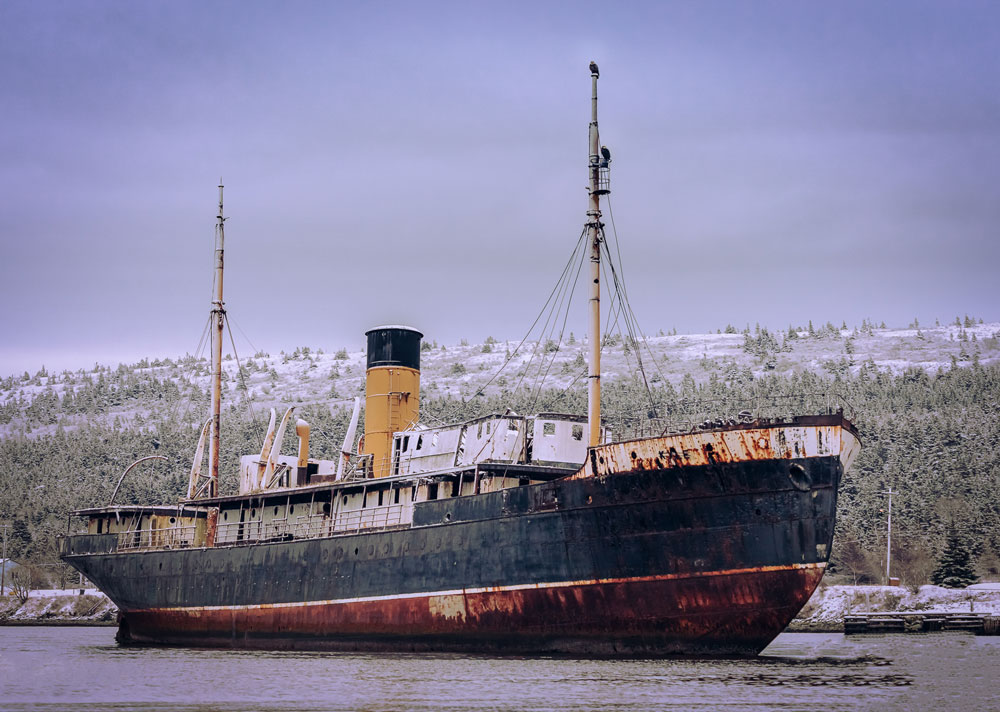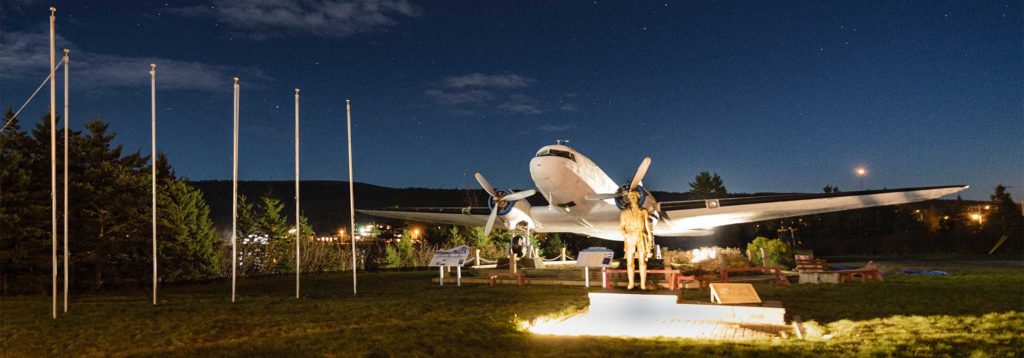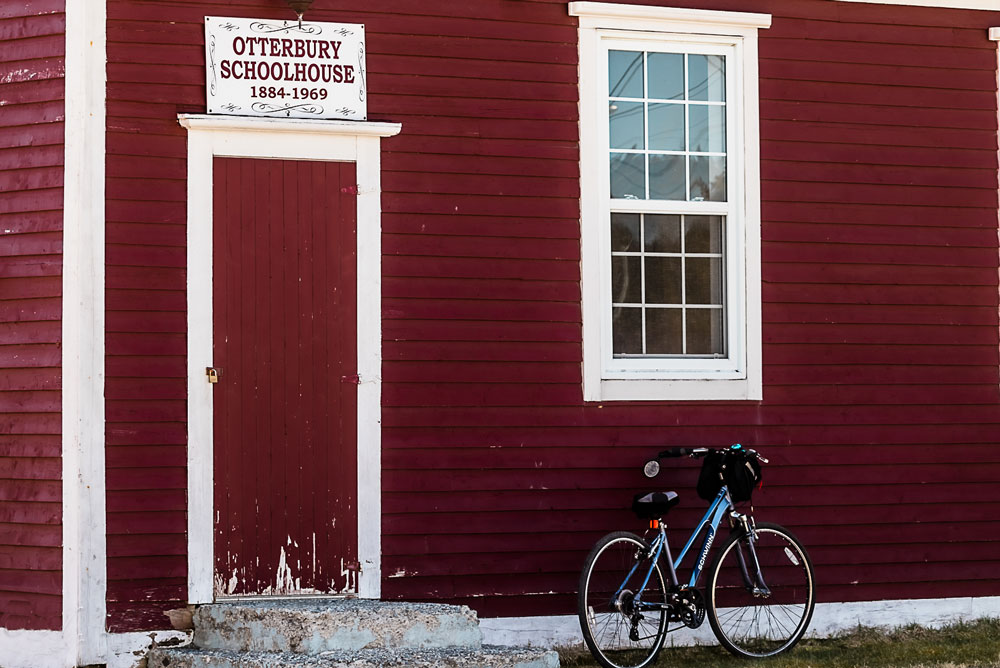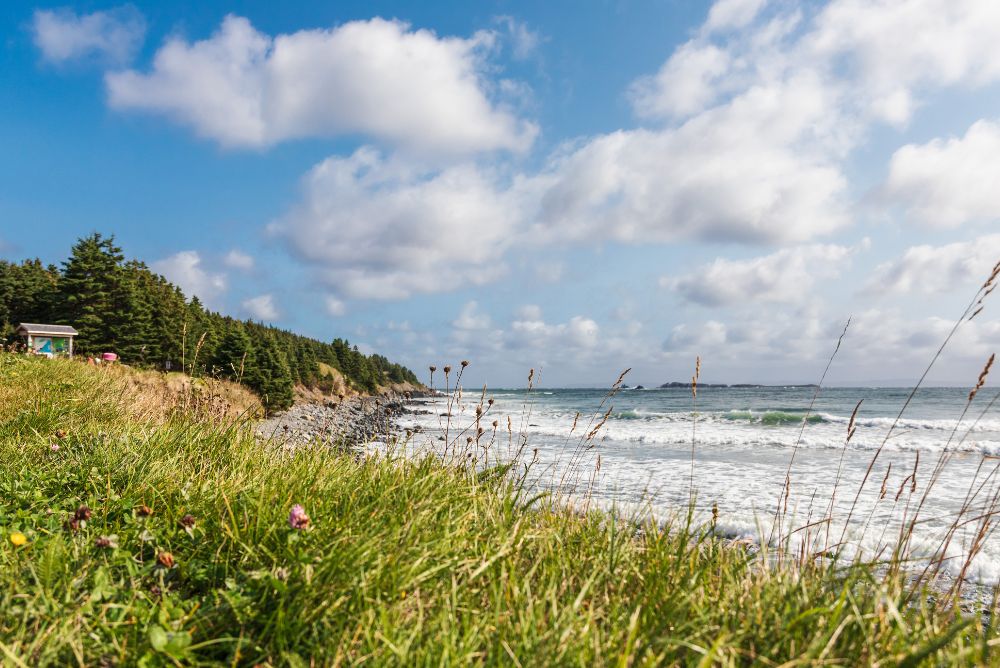SS Kyle

Built in Newcastle, England in the early 1900s, the famous steamship sits prominently in our harbour as an eye-catching landmark. Nicknamed the “Bulldog of the North” and renowned for its speed, the vessel spent decades as a ferry from the Newfoundland to Labrador and the Arctic beyond.
Eventually becoming a sealing vessel, the ship was damaged on one fateful expedition and brought here for repairs. On February 4, 1967, a storm blew the Kyle from its moorings, carrying her to the mussel bank in Riverhead, where she has sat ever since.
The SS Kyle remains a marquee attraction in Harbour Grace, attracting hundreds of international visitors each year. The nearby Kearney Tourist Chalet houses artifacts and photographs of the famous vessel in the ‘Kyle Room’, with a beach boardwalk offering a spectacular view of the moored ship.
SS Kyle Timeline:
1912-13:
- The SS Kyle is built in Newcastle-on-Tyne, England, by Swan Hunter and Wigham Richardson.
- She measures 220 feet (67m) in length, 32 feet (9.8m) in width, and 18 feet (5.5m) in depth. Its gross tonnage is 1,055 tonnes.
1913:
- The Kyle arrives in St. John’s as part of the Reid Newfoundland and Labrador Company’s Alphabet Fleet.
- It’s primarily used as a transport between the island and Labrador. It also does the Port aux Basques-North Sydney ferry run for several years.
- Nicknamed the “Bulldog of the North,” it’s renowned for its speed, notching at 19 miles per hour, impressive for a ship of that size.
1923:
- The Canadian National Railway acquires the ship from the Reid Newfoundland and Labrador Company.
1927:
- The Kyle gains international recognition, discovering the wreckage of the Old Glory aircraft after its failed attempt to fly across the Atlantic.
1958:
- The Kyle is sold to Arctic Transport Limited, who change its name to Arctic Eagle.
1961:
- Carbonear firm, Earle Brothers Ltd, purchase the ship and return her original name.
- Under Captain Guy Earle, the SS Kyle is converted to a sealing ship, bringing sealers to the ice floes for several successive springs.
- On one expedition, the ship is damaged and docked in Harbour Grace for repairs.
1967:
- A storm and strong northeast wind blows the Kyle from its moorings, carrying her to the mussel bank in Riverhead, Harbour Grace, where she has remained ever since.
1972:
- The Newfoundland and Labrador government purchase the Kyle for $4,000.
1997:
- The ship’s exterior is repainted through federal and provincial funding.
Today:
- The SS Kyle remains a marquee attraction in Harbour Grace, attracting hundreds of international visitors each year.
- The nearby Kearney Tourist Chalet houses artifacts and photographs of the famous vessel in the ‘Kyle Room’, with a beach boardwalk offering a spectacular view of the moored ship.

Amelia Earhart
The iconic aviator’s record-making transatlantic solo flight embarked from Harbour Grace on May 20, 1932.
While in Town, Earhart had a short visit at the Cochrane Hotel, where the proprietress Rose Archibald famously gifted her tomato juice and a thermos of soup. Her single engine plane left our airstrip at approximately 7:20 p.m.
For fourteen hours and fifty-six minutes, Earheart dealt with malfunctions, flames, fog and ice before landing at a farm outside of Derry, Northern Ireland. The proprietors of the farm offered her food and lodging and she told them Rose Archibald’s tomato juice had been her last meal since leaving North America.
Statue
In 2007, on the 75th anniversary of Earhart’s flight, a statue of the aviatress was placed in the Spirit of Harbour Grace Park. Site design came from Lorne Rostotski, the inspiration and funding from Roger Pike. Sculpted by Luben Boykov, the statue stands as a permanent reminder of Earhart’s special history in Harbour Grace.
Street Address: 468 Water St, Harbour Grace, NL

Spirit of Harbour Grace
The Spirit of Harbour Grace is a Douglas Aircraft Corporation DC-3, considered “the aircraft that changed the world.” This particular model was manufactured in 1943 in Santa Monica, California. It was commissioned to the United States Air Force for use in WWII and saw action in the North African theatre.
After the war, it was used by various companies throughout the US and Canada before being purchased by Harbour Grace resident Roger Pike in 1977. The accomplished aircraft transported mail and cargo between the island and Labrador for years, before being retired and restored to its original condition in 1988.
In 1993, the Spirit of Harbour Grace was donated to the Town by the Pike family. This historic landmark now stands at Riverhead, forever commemorating the Town’s rich aviation past.

Airstrip
In 1927, Crow Hill, Harbour Grace was proposed as an ideal location for an airstrip facilitating an attempt to break the record for the fastest flight around the world, due to the province’s location as a waypoint between North America and Europe. It was also a great way to put the Town on the map in this new, exciting era of transatlantic aviation.
Work began on August 8, 1927. It took eighteen days, just in time for the arrival of the Pride of Detroit and pilot William S. Brock and Edward Schlee, president of Waco Oil Co, who were sponsoring the expedition. On arriving in Town, Brock and Schlee praised the new airstrip as one of the finest they’d ever seen.
The pair spent the night at the Cochrane House, a popular overnight establishment for aviators in Harbour Grace. The following day, the Pride of Detroit disembarked for Croyden, England, the first call for their proposed journey.
Today, the airstrip is still in use, with amateur aviation club Canadian Owners and Pilots Association (COPA) Flight 97 maintaining the land.
To visit the airstrip:
- Follow Military Rd onto Lady Lake Rd, a graded gravel road.
- Hang left when you come to the first fork in the road and turn left on Earhart Rd.
- We recommend parking at the bottom of Earhart Rd and making the short walk up to the airstrip.
- There, you’ll find a Government of Newfoundland and Labrador memorial plaque and Newfoundland’s oldest civilian airstrip.

Registered Heritage District
The Harbour Grace Registered Heritage District stretches from Point of Beach to the Roman Catholic Cathedral, along Water Street and surrounding areas and within the Town. The district is primarily residential, with some commercial properties interspersed, and includes all land, buildings, structures and rock walls confined to the established boundaries.
Harbour Grace enjoys a long history as a primary port and a once-thriving centre for the Conception Bay fishery. Much of the ornate domestic, institutional and commercial buildings in the district reflect the Town’s status throughout the 18th and early 19th century, such as the stone courthouse and St. Paul’s Anglican Cathedral.
Despite later economic hardship and a large-scale fire, Harbour Grace still retains a considerable number of its historic structures, many of which include distinct brick, stone and iron work, along with sophisticated designs.
In addition to St. Paul’s, the oldest stone church in Newfoundland and Labrador, the district includes the Cathedral of Immaculate Conception, seat of the area’s Roman Catholic diocese for over a century. Also within the district are a Customs House and the residence of the Customs Official, Hampshire Cottage.
Harbour Grace Courthouse
In 1830, funds were raised for a new Harbour Grace courthouse by taxing Conception Bay’s residents: for every 1000 quintals of fish shipped, $1 was given to the courthouse fund.
After raising enough capital, builder and architect Patrick Keough constructed the building from locally quarried stone. Its distinguishable, classical style is typical of many British colonial courthouses. The bottom of the building housed the jail.
In the 1840s, James Clancy, an Irish-born educator residing in Harbour Grace, painted a coat of arms for the courthouse. This ornate painting was visible above the magistrate’s desk for years. Today, Clancy’s coat of arms can be viewed at the Conception Bay Museum.
Many infamous cases were contested there. Most notably, the gibbeted remains of Peter Downing, the convicted murderer of Robert Crocker Bray, Samuel Comer Bray and Ellen Coombs, are buried somewhere on the property.
The oldest surviving public building in Newfoundland and Labrador, the courthouse was designated a National Historic Site on May 25, 1966.
Rev. Laurence Coughlan Memorial (National Historic Person)
History
Likely born in Drummersnave (Drumsna), Ireland, in 1740, Lawrence Coughlan is considered to be the first Methodist preacher in British North America. Historians maintain that he came to Newfoundland and Labrador in 1766, first as a missionary priest for the Church of England. However, his preaching became increasingly Methodist-influenced in Harbour Grace.
For eight years, Coughlan worked zealously in Conception Bay. He would publicly denounce individuals for working Sundays, causing disputes with the merchant class. He would also visit area fishermen and their families along the coast, organizing religious classes and preaching in Gaelic to the Irish immigrants.
He later opened a school and became Justice of the Peace for the area in 1770. In 1771, Governor John Byron dismissed Coughlan due to controversies with merchants and an allegation of bribery. When Coughlan returned to England, he had left behind a strong foundation of Methodism, a tradition which continues in North America to this day.
The Historic Sites and Monuments Board of Canada formally recognized Laurence Coughlan as a National Historic Person on May 17, 1965. A rock monument detailing Coughlan’s influence in Conception Bay stands at 6 Water Street W, Harbour Grace. This plaque was refurbished in 2017.
Conception Bay Museum
The Conception Bay Museum is located at 1 Water Street East, inside the old Customs House.
The building dates back to 1870. Any boats coming in and out of the harbour would be subject to tariffs and checks from the customs officer, who would work and live inside the building with his family. The staircase to the servants’ quarters can be seen in the Sewing Room.
After brief iterations as a medical clinic and Town Hall, the Customs House was converted to a museum in the 1970s by Jerome Lee, Pamela (Barton) Lee, and Martin “Mac” Lee. It is a designated Municipal Heritage Site.
Today, the Museum offers a unique heritage and cultural experience for those interested in the history of Conception Bay. Exhibits include:
- an ‘Aviation Room,’ where visitors can learn about Harbour Grace’s important role in transatlantic aviation (including the story of the world’s most well-known female pilot, Amelia Earhart!);
- a ‘Pirate Room & Fishing Room,’ which contains stories of pirate Peter Easton’s adventures in Newfoundland and Labrador and on the Atlantic and a presentation on the history of mercantile fishing and shipbuilding in the region;
- a ‘World War Exhibit‘ (with regimental uniforms), dedicated to the island’s military and naval legacy; and
- a ‘Period Setting Room,’ filled with traditional late-nineteenth-century artifacts.
Guests receive guided tours through each room, with presentations specially catered depending on age level, general comprehension and relevance. Tours run for roughly forty-five minutes.
In the park, visitors will find plaques commemorating Rev. Laurence Coughlan, ideological founder of Methodism in Newfoundland and Labrador, and Harbour Grace’s history of transatlantic aviation. A Newfoundland & Labrador Medical Association plaque remembers Sir Thomas Roddick, the Canadian surgeon, medical administrator and politician. The patio also offers an exceptional view of the bay and Harbour Grace Islands. You can take a walk down the steps to Colston’s Cove, the historic site where John Guy and his crew landed salt in October 1612. The steps and beach are accessible to visitors in the spring, summer and fall months.
In the summer months, the flags of prominent Harbour Grace merchant firms and the solid black pirate flag of Peter Easton are flown from poles next to the building.
The popular Haunted Harbour Grace event takes place in the fall during the Halloween season.
Early History of the Railway in Harbour Grace
October 4, 1884, a railway line from St. John’s to Harbour Grace, was completed —the first one constructed on the island. The first train ran over the track on November 22, 1884.
The railway maintained a regular schedule, with the first train leaving at 7:45 a.m. and returning at 2:00 p.m. The second train would leave at 5:00 p.m. or later. The line was relatively successful, paying modest returns and opening Harbour Grace to the wider Avalon Peninsula (and, later, the entire island).
However, bondholders were ultimately not satisfied with their investment, eventually selling the Harbour Grace Railway to the Newfoundland and Labrador government for around $1.5 million in 1896. The branch line operated for fourteen years before the main line was completed in 1898.
Harbour Grace Railway Station
The Harbour Grace Railway Station was built in 1884, to accompany the branch line.
In 1898, Robert G. Reid took ownership of the station, along with the entire island’s railway interests. The colour of the station changed from ochre red to yellow and green—standard among Reid Newfoundland and Labrador Company stations. The station contained three rooms—the waiting room, express room and main office—and two ticket windows.
The station closed on March 31, 1984, the last train running later in September. On May 13, 1996, the Harbour Grace Historical Society obtained custody of the building. The group used the station as their regular meeting place, later converting the building into a museum.
It was later renamed the Gordon G. Pike Railway Station Heritage Museum and Park, after the former mayor and leading member of the Historical Society. The museum regularly operated during the summer for years, eventually closing due to needed repairs.
On October 5, 1996, the station became a Municipal Heritage Site. In 2016, the Heritage Foundation of Newfoundland and Labrador designated the station a Registered Heritage Structure. In 2017, the station underwent exterior renovations and was converted to its original ochre red colour. In 2018-19, the interior of the station was restored and repainted through funding from the provincial government. In fall 2019, the Town of Harbour Grace won Newfoundland and Labrador Historic Trust’s prestigious Southcott Award for Heritage Restoration for their efforts to revive the Harbour Grace Railway Station.

Otterbury Schoolhouse
Early survey maps indicate Otterbury as the area roughly between the beginning of Water Street, Harvey Street, and Lee’s Lane. Built as early as 1884, the schoolhouse was a traditional, one-room educational institution for Roman Catholic youth in Riverhead and the Otterbury area. The school was located on Water Street West.
The year it opened, there were 45 students registered. Like other schools of its era, it was heated by a wood-burning stove and the students, especially the boys, took turns getting the firewood. There was an outdoor bathroom and all students were responsible for helping keep the school clean.
In the 1930s, Ms. Helena Power was the teacher at Otterbury. She had previously taught in the United States before coming to Newfoundland. Although Latin was taught in schools at the time, she taught French. Power later published a book, “More Stories from Dickens” [1961], which retold the famous author’s stories for children. Around this time, an average of 50-60 students attended each year.
The school officially closed in 1969. Gordon G. Pike and the Harbour Grace Historical Society helped remodel the deteriorated structure in the late 1990s. However, years later, repairs were needed again. The schoolhouse was then moved to its current location, near the Kearney Tourist Chalet and the S.S. Kyle, under the direction of Albert (Bud) Chafe. The exterior was repainted in fall 2017.
Still featuring its original historic architecture, Otterbury Schoolhouse was designated a Municipal Heritage Site by the Town of Harbour Grace on January 10, 2006.

Pirate’s Path Trail & Coastal Conservation Area
The Pirate’s Path Trail is a 7.2-kilometre moderate to difficult linear return (“out-and-back”) trail in Harbour Grace, featuring Conception Bay’s best views of the historic Harbour Grace and Carbonear Islands. To view a map of the trail before visiting, visit our Google Maps page.
The Pirate’s Path Coastal Conservation Area—one of three Conservation Areas in Harbour Grace—follows the coastline from Bears Cove to Cookroom Cove. Sheltered beaches provide caplin spawning habitats which attract a myriad of seabirds. Seabirds nest in the burrows and crevices along the cliffs, especially black guillemots and the bald eagle. At Cookroom Cove, a historic duck hunting blind highlights a history of wildlife awareness in the area. To learn more about conservation efforts in Harbour Grace, visit the Stewardship Association of Municipalities’ website.